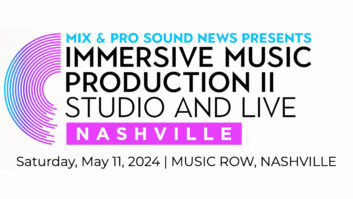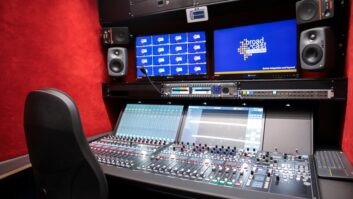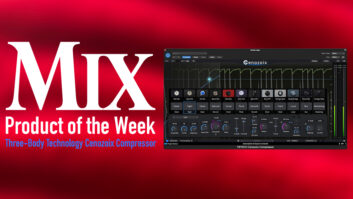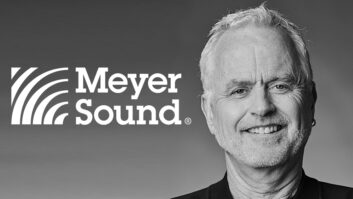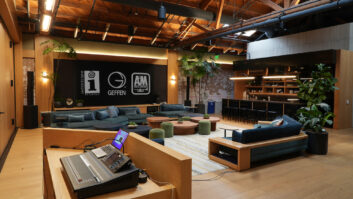While the rest of the world was listening to the likes of Janet Jackson’s “Escapade,” New Kids On the Block’s “Step by Step” and Wilson Phillips’ “Hold On,” indulging themselves in everything pop in 1990, a folksinger was making her way around small clubs and coffee houses, constantly touring and exposing a new generation of music fans to a different side of the tracks — her vision of reality. Preaching her own gospel, Ani DiFranco’s first albums brimmed with an awareness of the sociopolitical/economic situations in her hometown of Buffalo, N.Y., and across the nation. Crowds flocked to see this energetic, charismatic singer/songwriter expose a social consciousness that seeped through poetic melodies and the seemingly casual strumming of an acoustic guitar.
DiFranco is a woman determined to be heard. Since 1990, she has released 13 self-produced albums, including two collaborations with storyteller Utah Phillips. With each release, she delivers compelling rhythms and harmonies that extend into the areas of rock, punk and spoken word, but always find a home in the folksinger way of life — keeping it simple and honest and doing it all on her own. Despite her tremendous accomplishments, many critics have found DiFranco’s lyrical style too aggressive, too far removed from the mainstream. And they’ve found their ammo within her lyrics — in their sometimes stark realism.
Certainly, much of DiFranco’s success has come from the appeal of those lyrics. “I don’t know how people take [the lyrics], it’s a bit of a mystery to me,” DiFranco says. “I suppose each person hears things differently. In terms of being a poster child [for feminism], there are probably ideas about self-empowerment or about becoming one’s self that are attractive or exhilarating to young women who maybe are just becoming acquainted with those feelings for the first time. Like, ‘Maybe I don’t have to put up with this,’ or ‘Maybe I don’t agree with this,’ or ‘Maybe I want to wear this.’ So I guess there is room for a pretty visceral emotional response there. Themes of self-empowerment or even just self-questioning or exploration come up a lot in my songs.”
Recording since she was 20, this prolific singer/songwriter/musician/producer infiltrated the music scene from the fringe. She never signed with a major label, opting instead to create her own record company, Righteous Babe Records, which allows DiFranco to have full control over her artistic ventures. Now, too, the label also hosts other artists DiFranco believes in, including the DiFranco-produced Drums ’n’ Tuba. The label has grown to become a touring company, a management company, a music publishing company and the Righteous Babe Foundation, a nonprofit organization that seeks grassroots solutions to real-world problems.
Working against the mainstream, DiFranco has nonetheless managed to make her presence known in the music industry. Besides touring successfully year after year, her last four albums have made Billboard‘s Top 200, and her double live album, Living in Clip, went Gold. She has received six Grammy nominations and was included in VH-1’s “100 Greatest Women of Rock,” which called her “one of the most influential musicians of the 1990s.”
Her latest effort, Revelling/Reckoning, another double-disc CD, finds DiFranco expanding in yet another direction. The addition of a full band creates a problematic hurdle for critics wishing to simplify her and keep her on the fringe. And, at the same time, the release creates yet another reason why fans love her — DiFranco steadfastly fails to compromise her artistic vision.
“I’ve got a new, improved and expanded band. I’ve got a horn section now, so that’s pretty new for me,” DiFranco says. “I’ve always had a huge hard-on for brass, and two summers ago, I did a tour with Maceo Parker [who has worked with DiFranco on the past couple of CDs, including the new release], and after a month of hanging with him, playing, sharing music together to the point of no return, it was like, ‘Oh, now I have to have my own horn section.’ So this is the first record with all six of us; my band.”
The new and improved band on the record consists of multi-instrumentalist DiFranco on her usual acoustic and electric guitars, as well as some drums, bass, tamboritza, tongue drum, shakers and keys; Shane Endsley on trumpet and vocals; Daren Hahn on drums and vocals; Jason Mercer on bass, kazoo and vocals; Hans Teuber on reeds (flute, saxophone, clarinet) and vocals; and Julie Wolf, a longtime fixture in DiFrancoland, on keyboards and vocals.
But even with the addition of new instruments and talents, DiFranco sticks to what she knows best: maintaining her edgy folk sensibilities on Revelling and clinging to her acoustic guitar on the mostly solo acoustic second CD, Reckoning. And, as on previous releases, DiFranco continues to take control of her musical destiny by planting herself behind the console.
“Initially, and certainly for the first 10 years, [I produced my records] out of necessity,” DiFranco recalls. “I was making recordings without a record company and with no big record company to hire a big producer man. It’s not like I had some guy around saying, ‘Oh, I know how to do this.’ So, I was like a lot of young, independent musicians making their own recordings — I just made it up. And certainly, for the first five or eight albums, I had absolutely no facility with machines at all. I walked into a recording studio and I was your typical artist — ‘I sing and play guitar. Tell me where to sit.’ And then, even as I started to become familiar with, ‘Okay, what’s a preamp and what’s a compressor and how does this work?’ it took me many years to develop an aesthetic. Like, how do I want my guitar to sound? So the first seven records, all the sounds and the sensibilities of the recording had to do with the engineer who was there. He would choose the mic. So, basically, my involvement in mixing at that time was level setting. Over the years, I started to find my way around patchbays, and I started to understand being able to use gear and also develop a sense of involvement in the recordings.
“At this point, I’m just beginning to have a facility of my own in the studio, and it’s a journey. That’s another outlet of creativity — the recording studio — and for learning. Now it’s not so much out of necessity, but it’s because it’s another thing that I can do,” she says with a laugh. “And enjoy doing.”
Since the mid-’90s, Andrew Gilchrist has been DiFranco’s primary technical foil, working as an engineer for her both on the road and in the studio. That studio work, he explains, is usually ongoing rather than tied to a specific project. “When people ask me how the album started… it never really did,” he says. “There is no pre-production. It’s continuing. There are things that I’ve recorded [during this album] that will be on the next record, and I don’t even know it yet.”
Whatever time frame (or lack thereof), recording the album took place at DiFranco’s home studio, the Dust Bowl in Buffalo, N.Y., and, to a lesser degree, at an Austin, Texas, studio called the Congress House, where she’d worked on her previous album, To the Teeth. “This new record is the first one where most of it was recorded at home,” DiFranco says. “Certainly, the second record, which is almost all just me — that was a ‘middle of the night at home, wake up, turn on a tape machine’ kind of situation. It’s such a luxury to be able to work any time. The Congress House is a studio that I’ve been going to for so many years now; it’s been at least five. And it’s just a really small, unassuming, little studio in a tiny little house. It’s just really comfortable.”
While the record was still a work in progress, coming together throughout the last tour, DiFranco was rarin’ to go when she walked into the studios. “As soon as I write songs, I start teaching them to the band because we are always touring,” DiFranco says. “By the time we hit the studio, the songs are fully formed in their arrangements. Some songs start with a guitar riff, and even some on the new record started with a rhythm — a drumbeat or kind of a bass line — and then some of them start with words. It’s different all the time. It really depends on where the song lives, what its focus is. Certainly the second album, Reckoning, which is a very folk album — it’s very quiet, acoustic, mostly solo songs, so, of course, those really focus around the meaning and the words a lot more.”
The CD was recorded over the course of a year and, again, working within that “keeping it real” sensibility, DiFranco opted to record direct live to tape, except for most of the second disc, “which, of course, is just a lot of overdubbing, because it’s just me,” she says. But the band disc was cut live in the studio: “That’s my great luxury of having my band and all these musicians: We have the ability to go live to tape and capture performances, rather than this business of overdubbing.
“I think that when I first started making records,” DiFranco continues, “there was a lot of overdubbing involved, ’cause that’s how I was told to make records. It took me a bunch of years to figure out a lot of stuff for myself, like, ‘That’s dumb’ and ‘That doesn’t make for good recordings.’ I have a problem with the perfectionism side of the studio. I have all of these albums [I’ve done] and dubious versions of otherwise decent songs. My solution the past few albums has been to record direct live to tape, because I can only play a song a few takes before I’m bored.”
Like all of her previous albums, Revelling/Reckoning comes complete with in-studio banter, casual moments where DiFranco is caught on tape not knowing if tape was rolling, screwing up lyrics and just having a ball in the studio.
According to Gilchrist, “Traditionally, we make recordings really quickly — just put the stuff down and do it. We’ll do the songs a bunch of times. We’ll start in Buffalo [at the Dust Bowl], record the songs, have a band session, track the tunes, tour, book studio time in Texas [at the Congress House], do the same songs as if we never did them before.” In the end, many of these songs on the new album were tracked three different times in different studios, and then DiFranco chose the version of each that she liked best. There were, not surprisingly, some variations in equipment and even recording format from studio to studio. For instance, some of the songs were recorded to 2-inch analog, but most of the album was tracked to ADAT and edited in Pro Tools.
“As soon as Ani is playing, I’m recording,” Gilchrist says. “Even imperfections, personality or weird takes. We’ll create dozens upon dozens of tapes just in one week. We’re not gonna tweak until it’s ‘perfect,’ and I guess that goes back to folk music — the feeling of real people making music. We try to come out of the studio as unbutchered as possible. She smokes me in the studio, which is my world, which gives credit to her hands-on experience in the studio.
“I just got into Pro Tools editing,” he continues, “but I want to stay fairly basic. The idea of tracking to Pro Tools…I just don’t want to go there — I’m scared enough of tracking on ADATs. We didn’t do a lot of editing; just a few pieces. You know, the old-school style editing of just chopping sections if a song is too long. But we didn’t do a lot of tweaking. With Pro Tools, the possibilities are scary. It’s frightening how fast I can do it!”
The songs were recorded direct live to tape through either the Amek desk at the Congress House or the Soundcraft console at the Dust Bowl. Monitor pairs included Genelec 1031, Westlake BBSM 6, Yamaha NS-10M and Auratones. The equipment list also included an impressive array of outboard gear, including Avalon mic pre’s, a Joe Meek compressor and much more. “A Tube-Tech [CL1B] compressor pretty much sat on the vocals,” DiFranco says. “There are a couple of tube compressors always at work somewhere. TC Electronic has a new multi-effects [processor] called FireWorx that has come in real handy the past year of my life. We just got one, and it has so many different sounds; we’ve utilized it in all kinds of different ways. The Eventide H3000 SE is also a fave, which I use for all kinds of things — reverbs and delays and also the little Sampling function. Because I don’t really have any sampling gear, if I want to make a loop, [I’ll use] the H3000 or Jam Man.”
Gilchrist and DiFranco strive to keep the sound as natural as possible, but the engineer also notes, “We like to experiment a lot, try to get something that sounds like the studio that we’re in. I like to use a lot of mics and experiment with different ones. I’m a self-proclaimed gear freak, but I like to set up with mics I already know. I like to use the Sony C800 tube mic, because it sounds like she sounds. I also use a Manley Gold Reference mic and an Audix 111 large-diaphragm condenser mic, because it sounds right for her voice. We’ll use anything, depending on the song.”
“My vocal mic has been shifting depending on where we’re recording,” DiFranco adds. “Actually, all the mics are shifting. I’m constantly experimenting with guitar mics and overheads. There weren’t really any same ones for the whole record. It changes based on the guitar and the song. But I’ve kind of fallen into this new thing this last year or two of two mics on the guitar to get a stereo picture of the guitar in the room. Generally, one of them is sort of underneath my chin and pointing down, and the other one I have kind of underneath the bridge pointing up. Not pointing at the guitar [with either] — I find all kinds of problems when I actually face a microphone at a guitar anywhere. It sounds boxy or boomy or dull. But I so love the sound of my guitar just as my head floats above it. Then I also take a DI, usually for a punchy bass. On a fourth channel, I usually send my guitar to an amp. Acoustic guitar through an electric guitar amp has kind of been my thing for a bunch of years. You can kind of shift it between a more amp-y and a more acoustic sound in the mix.”
Gilchrist used a combination of room mics and close mics to record the new brass section. He found a Coles ribbon mic to be particularly good on brass. Other mics used throughout the recording sessions included Neumann TLM170 and -103, Royer R121 ribbon mics, and a plethora of AKG, Sennheiser and Beyer models. Gilchrist also tried working in different room settings to get more variation out of DiFranco’s amps and vocal mics, including recording in the bathroom “for a great room sound.”
DiFranco’s friend Maceo Parker joined up with the clan at the Congress House, adding some vocals and saxophone to the new release. (Parker also appeared on To the Teeth.) “I’ve been a huge fan of his for years,” DiFranco recounts, “and a couple of summers ago, I was going on an outdoor/shed tour, and we were looking for someone to open the show. And I was like, ‘Well, why don’t you try calling my musical hero?’ We just called him up to see if he wanted to do some shows. He’s been kind of family since then.”
And, according to Gilchrist, recording Parker’s sax couldn’t have been any easier. “Just put a mic near him and you get his sound. We used condenser mics — I think a Neumann TLM170 and U87s. He always sounds great; he’s that good. I put up the track, let him listen to it in the control room, he goes into the room and just does it. He only does three takes and he’s done. He tells me he’s done and I’m like, ‘Okay, that sounded great!’”
With all the recording finished, Gilchrist and DiFranco set out to pull the CD together and master the tracks, a process that turned out to be a revelation of its own.
“Mastering was scary,” Gilchrist admits. “There were so many DATs. I had so many spreadsheets open that I had a hard time trying to keep track of things. [Ani] would add songs when we were listening to things in playback, because she felt that something was missing. So, she would just do it and I would run tape. I would walk into the studio each day and not have any idea of what we were doing that day — if it’s an idea she has, screwing around or actually recording.”
“Initially, I thought I was just making one record,” DiFranco explains, “and then there were certain songs that didn’t really want to be put into one box with other songs. And then I started to conceive of it as two records. At first, it was just gonna be Reckoning, and then the idea for the second record came to me. And the flipside of ‘reckoning’ was the idea of ‘reveling.’ I guess, basically, the songs ended up kind of divided thematically along those lines. The Revelling record has a lot more complexly produced stuff and a lot more band material. And then the Reckoning record is much quieter and simpler.”
As with many projects, final playback exposed a few hidden surprises that, for the benefit of a natural sound, were kept in. “On one of the recordings,” Gilchrist reveals, “if you listen way under the tremolo and electric guitar, you can hear a TV. We were locking ADATs up to rough cuts of this movie, and we didn’t realize that we were going to get interference. But it sinked its way into the recording. We left it, but I can hear it now and say, ‘Oh well.’ But when we were dubbing for a sample CD for radio, I thought, ‘Wow, this sounds really good.’ Because in the past few months, I’m just hearing all those things that made me cringe.
“But this is a beautiful record,” he continues. “She just blows my mind. How fluid, so natural, it just comes out of her, and my job is just to keep up, speed-wise. And the hours we spent in the studios — there were times when I would say, ‘Hmm, it’s light again. I think we should stop.’ I’m just glad that the record is done. It was getting to be so long.
“We’ll just keep going, though. She’s like no one I’ve ever worked with or ever encountered. Her level of concentration and speed of activity are unreal. I mean, the quality is really good and her writing is incredible. Also, her guitar work is strangely overlooked.”
As for Ms. DiFranco, she’ll just keep doing what she loves and what her fans love her for: her powerful lyrics and melodies, the nearly hypnotic rhythms that seem to emanate from her without much effort. “I guess I’m most interested in writing what reflects someone’s reality, because I think that there are so many stories all around us that don’t necessarily find their way onto the TV,” she comments. “I think the act of telling one’s own story and broadening the palette of colors in a culture is a good place to start. I’m just doing what I do — touring and making records and otherwise living for music.”
Sarah Benzuly is Mix‘s copy editor.

